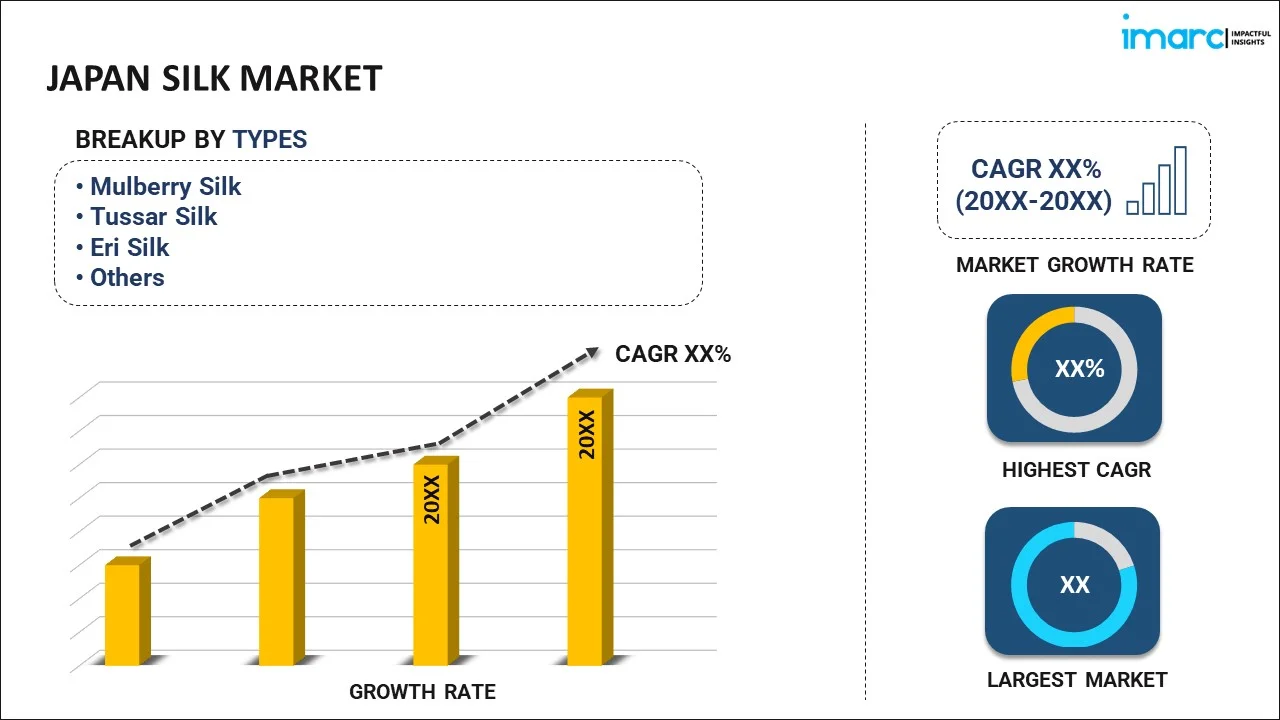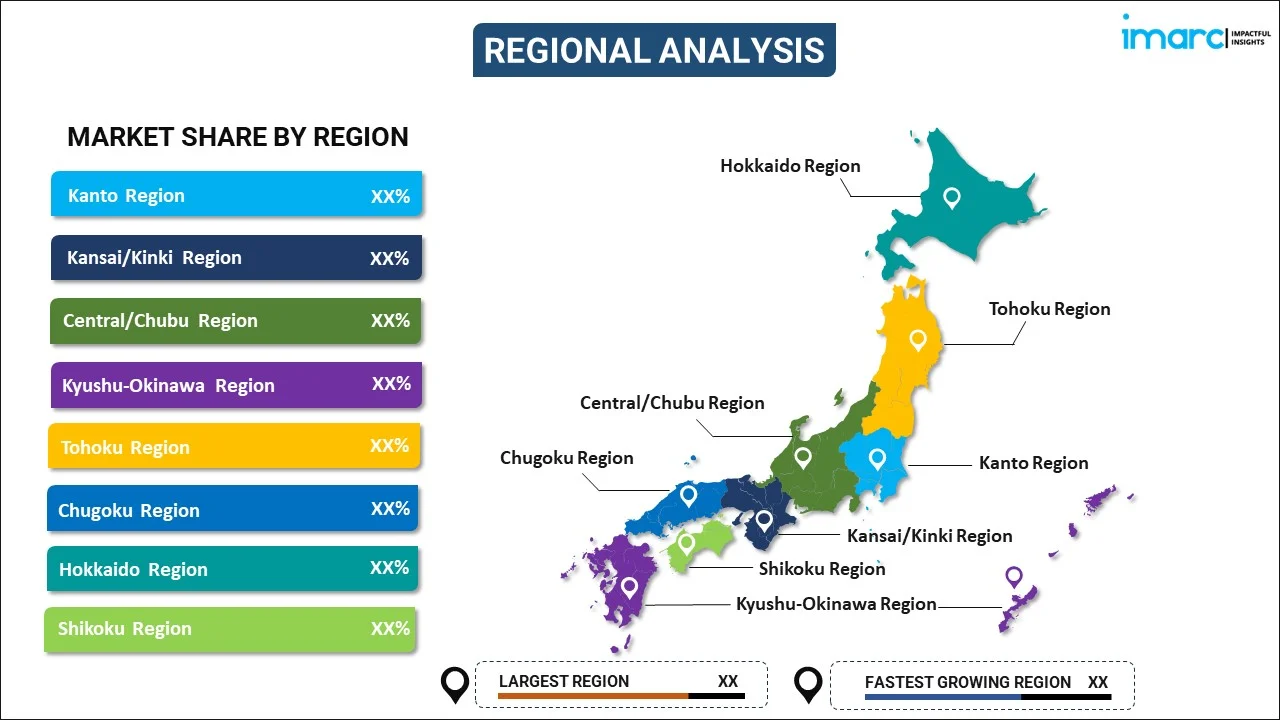
Japan Silk Market Report by Type (Mulberry Silk, Tussar Silk, Eri Silk, and Others), Application (Textile, Cosmetics, Medical), and Region 2025-2033
Market Overview:
Japan silk market size reached 10.5 Thousand Tons in 2024. Looking forward, IMARC Group expects the market to reach 15.0 Thousand Tons by 2033, exhibiting a growth rate (CAGR) of 3.7% during 2025-2033. The ongoing advances in sericulture techniques, such as improved breeding methods for silkworms, innovative reeling technologies, and developments in silk processing, that can influence the overall production efficiency and quality of silk, are driving the market.
|
Report Attribute
|
Key Statistics
|
|---|---|
|
Base Year
|
2024
|
|
Forecast Years
|
2025-2033
|
|
Historical Years
|
2019-2024
|
| Market Size in 2024 | 10.5 Thousand Tons |
| Market Forecast in 2033 | 15.0 Thousand Tons |
| Market Growth Rate 2025-2033 | 3.7% |
Silk, one of the most luxurious and sought-after fabrics, is a testament to the beauty and ingenuity of ancient craftsmanship. Derived from the natural protein fibers produced by silkworms, this exquisite material has captivated civilizations for millennia with its unparalleled softness and lustrous sheen. Renowned for its remarkable ability to regulate body temperature, silk is not only sumptuously smooth against the skin but also provides warmth in the cold and coolness in the heat, making it an ideal choice for a diverse range of climates. Its unparalleled strength, despite its delicate appearance, renders it both durable and delicate, embodying a paradoxical elegance that has made it a symbol of luxury and opulence throughout history. Whether used in the creation of elegant garments, luxurious bedding, or delicate home furnishings, silk continues to be revered as a timeless embodiment of sophistication and refinement, standing as a testament to the intricate craftsmanship and enduring allure of natural textiles.
Japan Silk Market Trends:
The silk market in Japan has experienced significant growth, primarily driven by various factors. Firstly, the increasing demand for luxury textiles and fabrics has propelled the silk market forward. Moreover, the rising disposable income among the middle-class population has significantly boosted the demand for silk products. Consequently, this has led to a surge in the production and consumption of silk, thereby stimulating market growth. Additionally, the growing awareness regarding the eco-friendly and sustainable nature of silk production has attracted environmentally conscious consumers, fostering the expansion of the silk market. Furthermore, technological advancements in the sericulture industry have enhanced the efficiency and quality of silk production, contributing to the overall market growth. Furthermore, the flourishing fashion industry, coupled with the rising trend of incorporating silk in haute couture and designer wear, has significantly augmented the demand for silk. Notably, the expansion of e-commerce platforms, which has further facilitated the accessibility and availability of silk products to a broader consumer base, is expected to drive the market in Japan during the forecast period.
Japan Silk Market Segmentation:
IMARC Group provides an analysis of the key trends in each segment of the market, along with forecasts at the country level for 2025-2033. Our report has categorized the market based on type and application.
Type Insights:

- Mulberry Silk
- Tussar Silk
- Eri Silk
- Others
The report has provided a detailed breakup and analysis of the market based on the type. This includes mulberry silk, tussar silk, eri silk, and others.
Application Insights:
- Textile
- Cosmetics
- Medical
A detailed breakup and analysis of the market based on the application have also been provided in the report. This includes textile, cosmetics, and medical.
Regional Insights:

- Kanto Region
- Kansai/Kinki Region
- Central/ Chubu Region
- Kyushu-Okinawa Region
- Tohoku Region
- Chugoku Region
- Hokkaido Region
- Shikoku Region
The report has also provided a comprehensive analysis of all the major regional markets, which include Kanto Region, Kansai/Kinki Region, Central/ Chubu Region, Kyushu-Okinawa Region, Tohoku Region, Chugoku Region, Hokkaido Region, and Shikoku Region.
Competitive Landscape:
The market research report has also provided a comprehensive analysis of the competitive landscape. Competitive analysis such as market structure, key player positioning, top winning strategies, competitive dashboard, and company evaluation quadrant has been covered in the report. Also, detailed profiles of all major companies have been provided.
Japan Silk Market Report Coverage:
| Report Features | Details |
|---|---|
| Base Year of the Analysis | 2024 |
| Historical Period | 2019-2024 |
| Forecast Period | 2025-2033 |
| Units | 000 Tons |
| Scope of the Report | Exploration of Historical and Forecast Trends, Industry Catalysts and Challenges, Segment-Wise Historical and Predictive Market Assessment:
|
| Types Covered | Mulberry Silk, Tussar Silk, Eri Silk, Others |
| Applications Covered | Textile, Cosmetics, Medical |
| Regions Covered | Kanto Region, Kansai/Kinki Region, Central/ Chubu Region, Kyushu-Okinawa Region, Tohoku Region, Chugoku Region, Hokkaido Region, Shikoku Region |
| Customization Scope | 10% Free Customization |
| Post-Sale Analyst Support | 10-12 Weeks |
| Delivery Format | PDF and Excel through Email (We can also provide the editable version of the report in PPT/Word format on special request) |
Key Questions Answered in This Report:
- How has the Japan silk market performed so far and how will it perform in the coming years?
- What has been the impact of COVID-19 on the Japan silk market?
- What is the breakup of the Japan silk market on the basis of type?
- What is the breakup of the Japan silk market on the basis of application?
- What are the various stages in the value chain of the Japan silk market?
- What are the key driving factors and challenges in the Japan silk?
- What is the structure of the Japan silk market and who are the key players?
- What is the degree of competition in the Japan silk market?
Key Benefits for Stakeholders:
- IMARC’s industry report offers a comprehensive quantitative analysis of various market segments, historical and current market trends, market forecasts, and dynamics of the Japan silk market from 2019-2033.
- The research report provides the latest information on the market drivers, challenges, and opportunities in the Japan silk market.
- Porter's five forces analysis assist stakeholders in assessing the impact of new entrants, competitive rivalry, supplier power, buyer power, and the threat of substitution. It helps stakeholders to analyze the level of competition within the Japan silk industry and its attractiveness.
- Competitive landscape allows stakeholders to understand their competitive environment and provides an insight into the current positions of key players in the market.
Need more help?
- Speak to our experienced analysts for insights on the current market scenarios.
- Include additional segments and countries to customize the report as per your requirement.
- Gain an unparalleled competitive advantage in your domain by understanding how to utilize the report and positively impacting your operations and revenue.
- For further assistance, please connect with our analysts.
 Inquire Before Buying
Inquire Before Buying
 Speak to an Analyst
Speak to an Analyst
 Request Brochure
Request Brochure
 Request Customization
Request Customization




.webp)




.webp)












